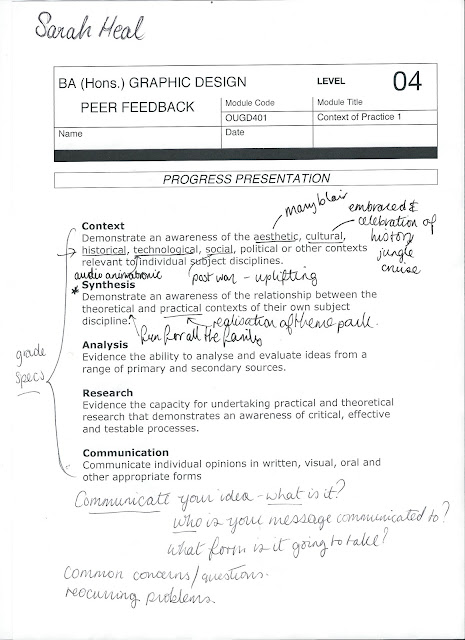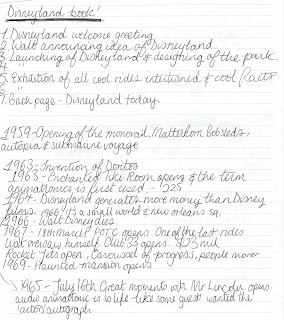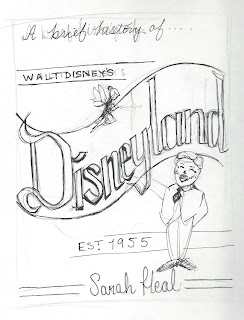'From Theory Into Practice'
Design, develop and produce a publication entitled; ' A Brief History of...' (completed with a subject of your choice).A publication can be anything you can read and extract information on. This includes blogs, websites, motion graphics, books, & magazines etc.
- Think about your audience!
- Be creative with your format!
- Think outside the box!
Evidence a deep knowledge of the...
- Historical & chronological information
- Social and cultural attitudes
- Technological advances
- Political attitudes
...of the time.
Be visual and experimental! Fulfil your choice of content and have fun with it.
Module deadline/ studio deadline: 7th May 2013.
-------
After reading the brief, I have to decide what contextual subject to visualise in the publication.
I know straight away that I don't want to design something plain or modernist, and think I can be more experimental and engaging if the subject is more obscure.
I have quickly made a list of obscure art movements/ contextual subjects that I know I can provide depthy research and that I think would translate well visually:
1. Victorian Modernism Newsprint
- turn of the 20th century
- invention of the telephone, lightbulb and electricity.
- Train travel and concrete are invented.
- steampunk-style inventions and innovations in steel architecture.
- Focus on Parisian world fair in 1889 - perhaps create newsprint advertising new technology.
- Utilise paper craft to recreate viewfinders?
2. 60's/ 70's Bohemian Psychedelica
- photo album/ scrapbook of festivals in San Francisco
- Diary?
- Documentation of Woodstock Festival
3. Dadaism
- Book made out of wood?
- sculpture?
4. Avante Garde cinema
- some pages to be printed on acetate like slides of a film?
- experiment with light in book...
5. Punk
- Could be book about punk written in formal institutional format, savaged and vandalised in the style of anarchy.
6. Disneyland ( a personal interest )
- book could transition from 2d to 3d, to represent cartoon to screen to theme park.
- Could also transition from black and white to colour to represent timespan.
- Interactive elements and removable parts.
7. Surrealism
- Plain format style of book, printed in reverse
- features book box but slides out wrong side (back to front)
- Book would feel uncomfortable, and unfamiliar to the reader.
- Boring, grid formatted pages would get progressively distorted.
------
After showing all of my ideas to my peers at the crit on 19th March 2013, I decided to go with the history of Disneyland book. My peers said that because I had so many different and fun ideas for the Disneyland book, and because it was a personal interest so I had extensive knowledge, that this would be the most elaborate and successful idea.
Why Disneyland? How does this relate to art/ design?
Because I already knew so much about Disneyland, I began starting to list all the things I would want to include, and try to fulfil the assessment criteria. I also knew that I wanted to feature pop up/ interactive paper elements to integrate the 'fun' vibe of the book and so I was keeping in mind what kind of things I could include for these features.
I also wrote up a possible chronology of pages. I estimated around 7 or 8 pages would be required. I started to produce some (really rough) sketches:
So I finally started to develop, as now I had no choice but to just go with what I had already decided.
The chronology of the final Disney book were refined down to :
page 1 - Disneyland opening day speech on a plaque
page 2 - 'a gleam in Walts eye' - an insight into where the idea for Disneyland came from
page 3 & 4 - why Walt was discouraged from the idea of Disneyland - to put into context the radical idea and development of Disneyland.
page 5 & 6 - development, building and opening of Disneyland
pages 7 & 8 - exhibition of all the greatest innovations/ attractions at Disneyland and the opening of all of the different parks.
As I started to sketch and develop digitally, I quickly ran out of time.
I decided to abandon the idea of a 3 tier carousel book, and have it double sided instead.
This would mean that there would now be no fiddly/ time consuming paper engineering - just a double sided document.
I started integrating all of my images like this. This page being the page showing the different 'lands' of opening day. I used different layer masks to mix the photo with the illustrations, such as the rocket top right. I used the clone tool on Photoshop to get rid of the real rocket in the photo, and replaced it with mine in illustrator. I repeated the image and used a layer mask to include the 2 men in the foreground of the picture. I played around with the layer mask to make my illustrations part of the images. All of the photos I included are pictures of Disneyland park.
Printing
Why Disneyland? How does this relate to art/ design?
- The birth of Disneyland saw a massive surge in consumerism & advertising
- Great innovations in art technology were made purely for Disneyland with the invention of the animatronic etc.
- It turned the amusement park into an art form, and used art & engineering to immerse people in the art.
- New advances in architecture were made because/ for Disneyland.
- Several inventions such as Doritos were created and marketed well because of their affiliation with Disneyland.
- Disneyland increased interest in the Disney company and so became one of the first companies with an obsessively loyal fan base.
My project proposal form
I began writing up a detailed timeline of what I thought was all of the key elements to include. This included things like big opening days, innovative inventions/ attractions.
I also wrote up a possible chronology of pages. I estimated around 7 or 8 pages would be required. I started to produce some (really rough) sketches:
This double page was to integrate all of the greatest rides/ attractions in one place. It features lots of attractions from the 1959 Tomorrowland expansion. I was going to do movie poster style artwork with dramatic perspectives.
This double page featured the designing and the 1-year rushed build of the first Disneyland in time for opening day. It would have blueprints falling down the page and a long queue. I thought that the queue could be in the foreground and could be 3d and have layers of these. The page would be in layers looking at the railroad station and the castle in the background.
I found myself rather stuck after just 2 sketches. I couldn't visualize how to tell my story, even after countless lists I had hit a wall. I decided to take my sketches and a couple of mood boards to the peer-ran crit:
As I didn't really know what was wrong with my idea, I just knew it wasn't working, I didn't really receive very much constructive feedback and didn't come away with any more ideas. On paper, my idea sounded strong.
I plodded on with more sketches, and decided to do the bits I knew I could do. I wanted somewhere to include a cartoon picture of Walt Disney himself, and so I began sketches and development for that.
I wanted to make Walt cartoon-like, most resembling something in the style of Josh Agle (Shag) because his artwork is Disney friendly, has a strong 1950s yet contemporary style, which is the era Disneyland opened and much of it's marketing to this day is in this style.
In this image I am playing around with Walt's appearance.
Here I am doing a few sketches for people in the crowds & the body of Walt. Some people would have to be in the foreground at least, so I knew that I would have to produce drawings for them.
I liked the idea of re-tweaking the Disneyland logo for the front cover.
I wanted a lot of the graphics to be like the ones found in the Disneyland park itself. This meant very typographic based banners and designs to decorate the book with.
A couple of crude sketches in the style of Shag for people of the crowd. These people are dressed typically in fashion of the 1950s, something the crowd might have worn on opening day.
I decided to digitise a couple of my sketches, and digitally develop them so I had more unique images to work with.
By tracing over my sketch with the pen tool, and playing around with different line points and gradients, I was able to create an image of Walt Disney that remotely represented him! I was really happy with the result, which gave me a bit more confidence in my idea. I posted the image to the Graphic Design page on Facebook for some feedback and there were a lot of positive responses - a few said he looked a little bit too young/ a bit too surprised because his eyebrows were so high. Every reference photo I found and video I watched his eyebrows really are that high!
It was hard creating something with regrettably hardly any planning. And although I was happy with the result of this page, it was created without any knowledge of paper size and would soon suffer from cropping and layout of the final design.
From my sketch of the 1950's lady, I was able to use the same techniques to create the digital image. The different arms and legs were to be added when I knew exactly where she was going to go!
From the digital version of the 1950s lady, I was able to create a 1960s lady and a girl with accurate 1960s merchandise.
Again, by using the same techniques, I digitised the sketch of the 1950's man, complete with bowling shirt.
After another mini crit, I was growing increasingly worried about my design, as it really wasn't materialising. Other projects were getting in the way, and poor time management meant that my beloved Disney book was falling behind. I decided that I had to not do a pop up book, as by this time there was not near enough time to refine the pop ups as well as everything else that needed to be done.
I changed my idea, as I still wanted something that would be of interest to the typical Disneyland fan - so I chose a carousel book:
Examples
This would mean that there would still be an element of interactivity and a 3D effect but would be a lot more time efficient, as the 3d effect could be developed out of one page.
So I finally started to develop, as now I had no choice but to just go with what I had already decided.
The chronology of the final Disney book were refined down to :
page 1 - Disneyland opening day speech on a plaque
page 2 - 'a gleam in Walts eye' - an insight into where the idea for Disneyland came from
page 3 & 4 - why Walt was discouraged from the idea of Disneyland - to put into context the radical idea and development of Disneyland.
page 5 & 6 - development, building and opening of Disneyland
pages 7 & 8 - exhibition of all the greatest innovations/ attractions at Disneyland and the opening of all of the different parks.
As I started to sketch and develop digitally, I quickly ran out of time.
I decided to abandon the idea of a 3 tier carousel book, and have it double sided instead.
This would mean that there would now be no fiddly/ time consuming paper engineering - just a double sided document.
Developing a drawing of the Jungle Cruise ride. It was important to me to include 4 or 5 rides on the opening day page that would represent the mix of cultures in Disneyland and what that meant in an all-American californian community.
screenshot of the development of pages 5 & 6. On the left I am drawing the Main street station and on the right I am just starting the Jungle Cruise ride.
Copying and pasting a crowd together for background.
Using a screenshot from the Disneyland tv show, I used the pen tool to trace around the lettering, and then staggered each letter over a waved line like my original sketch.
Using all the same techniques, IE the pen tool and the gradient tool, I was able to trace over a photograph of the Disneyland castle to use in my book.
Using the same image of Walt, I was able to change his pose and put him in many different backgrounds. I decided to start using old black and white photography in with my illustrations to save time, and I really liked the way my images were coming out. This also meant that it was a bit more historically supported.
Drawing 2 girls to go in the teacups.
I really regret not pacing myself and giving myself time to work on this book, as I missed out on vital feedback that could have made this book what I had originally visualized. Because of this lack of time, I had to move more quickly and subsequently less intricately. IE, whatever I drew I would have to go with it and not compromise.
The final book in stages:
I always wanted to include the opening day speech to the first page of the book, as I thought it was a really suitable introduction. I tried to make it in the style of Disney with the Tinkerbell glitter and shine. I also used a font that to me resembled the cursive script like Disney's handwriting.
The second page features an old 1950s television showing the Disneyland show. In the bodycopy, I talk about the idea of Disneyland and what Walt envisioned. This would explain the context of the Disneyland development and design.
The third page features a photograph of Coney Island in the 1950's. Lots of existing amusement parks of the time were in decline and were dangerous, dirty places that you wouldn't necessarily like your kids to roam free in. This is exactly the opposite of what Walt envisioned for Disneyland. Because of this amusement park decline though, lots of people predicted failure for Disneyland. I also talk about the second world war, and the financial struggle the country was going through. This meant that there wasn't a market that were willing to part with their money to visit Disneyland - in theory.
The fourth page narrates the book and carries along the story to help the reader.
The fifth page is a photograph of main street in Disneyland on opening day, with a collage of my drawings as well. It shows Walt giving the opening day speech, and my historically accurately dressed crowd behind.
The sixth page is continuing the same thing, exhibiting the most diverse attractions of opening day.
The last double page shows the Matterhorn, the submarine voyage, skyway and the monorail on a photograph of a landscape similar to the one Walt envisioned for this part of Disneyland. I include a fairwell tagline for the book but there is more.
I needed to include something to make this more historically educational and accurate, so I included a comprehensive and accurate timeline on the back of these pages:
This was in the same font and style as the other pages of the book.
The finished front cover design didn't require any different techniques previously used in the book.
The front and back cover would be ever so slightly bigger than the pages, and would be mounted on mountboard. It wouldn't need to have a spine, because the book opens both ways.
I managed to get my book printed at the very last minute, and so I didn't really think about the paper stock other than it had to be card. Now that it is printed , I think that I would have chosen this stark white stock anyway, as this kind of book is best suited to clean, crisp bleach card.
I printed it by reprographics and assembled using a scalpel and double sided tape - spraymount caused it to curl and pritt was not strong enough.
I encountered a couple of problems in assembly- in particular putting the back pages onto the front pages- at first it was wonky and I decided to assemble the back pages one at a time.
The constatina effect works really well in my opinion!
The final book:
I am pleasantly surprised at the final outcome of my book - but you don't have to read between the lines to see that I am thoroughly disappointed at how much I messed up on what was supposed to be my best work so far - I would even go so far as to call it my worst work. I hope that it successfully fulfils the assessment criteria. I know what steps I need to take next time to NEVER let this happen again - I want to be proud of my work!
My evaluation can be found here.
Thanks for reading




















































No comments:
Post a Comment